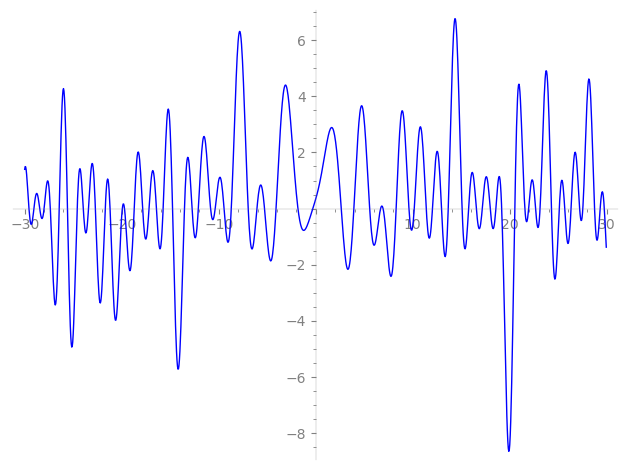| L(s) = 1 | + (−0.477 − 0.477i)2-s + (−1.72 + 0.114i)3-s − 1.54i·4-s + (0.814 − 2.08i)5-s + (0.879 + 0.770i)6-s + (−2.51 − 0.835i)7-s + (−1.69 + 1.69i)8-s + (2.97 − 0.396i)9-s + (−1.38 + 0.604i)10-s + (0.137 + 0.0791i)11-s + (0.177 + 2.66i)12-s + (−0.549 + 0.147i)13-s + (0.799 + 1.59i)14-s + (−1.16 + 3.69i)15-s − 1.47·16-s + (−1.11 + 4.15i)17-s + ⋯ |
| L(s) = 1 | + (−0.337 − 0.337i)2-s + (−0.997 + 0.0662i)3-s − 0.772i·4-s + (0.364 − 0.931i)5-s + (0.359 + 0.314i)6-s + (−0.948 − 0.315i)7-s + (−0.598 + 0.598i)8-s + (0.991 − 0.132i)9-s + (−0.437 + 0.191i)10-s + (0.0413 + 0.0238i)11-s + (0.0511 + 0.770i)12-s + (−0.152 + 0.0408i)13-s + (0.213 + 0.426i)14-s + (−0.301 + 0.953i)15-s − 0.368·16-s + (−0.269 + 1.00i)17-s + ⋯ |
\[\begin{aligned}\Lambda(s)=\mathstrut & 315 ^{s/2} \, \Gamma_{\C}(s) \, L(s)\cr =\mathstrut & (-0.938 - 0.346i)\, \overline{\Lambda}(2-s) \end{aligned}\]
\[\begin{aligned}\Lambda(s)=\mathstrut & 315 ^{s/2} \, \Gamma_{\C}(s+1/2) \, L(s)\cr =\mathstrut & (-0.938 - 0.346i)\, \overline{\Lambda}(1-s) \end{aligned}\]
Particular Values
| \(L(1)\) |
\(\approx\) |
\(0.0604625 + 0.338414i\) |
| \(L(\frac12)\) |
\(\approx\) |
\(0.0604625 + 0.338414i\) |
| \(L(\frac{3}{2})\) |
|
not available |
| \(L(1)\) |
|
not available |
\(L(s) = \displaystyle \prod_{p} F_p(p^{-s})^{-1} \)
| $p$ | $F_p(T)$ |
|---|
| bad | 3 | \( 1 + (1.72 - 0.114i)T \) |
| 5 | \( 1 + (-0.814 + 2.08i)T \) |
| 7 | \( 1 + (2.51 + 0.835i)T \) |
| good | 2 | \( 1 + (0.477 + 0.477i)T + 2iT^{2} \) |
| 11 | \( 1 + (-0.137 - 0.0791i)T + (5.5 + 9.52i)T^{2} \) |
| 13 | \( 1 + (0.549 - 0.147i)T + (11.2 - 6.5i)T^{2} \) |
| 17 | \( 1 + (1.11 - 4.15i)T + (-14.7 - 8.5i)T^{2} \) |
| 19 | \( 1 + (3.32 + 1.91i)T + (9.5 + 16.4i)T^{2} \) |
| 23 | \( 1 + (1.02 + 0.274i)T + (19.9 + 11.5i)T^{2} \) |
| 29 | \( 1 + (-2.59 - 4.48i)T + (-14.5 + 25.1i)T^{2} \) |
| 31 | \( 1 + 5.05T + 31T^{2} \) |
| 37 | \( 1 + (3.10 + 11.5i)T + (-32.0 + 18.5i)T^{2} \) |
| 41 | \( 1 + (4.20 + 2.42i)T + (20.5 + 35.5i)T^{2} \) |
| 43 | \( 1 + (0.495 - 1.84i)T + (-37.2 - 21.5i)T^{2} \) |
| 47 | \( 1 + (2.76 + 2.76i)T + 47iT^{2} \) |
| 53 | \( 1 + (-12.4 - 3.32i)T + (45.8 + 26.5i)T^{2} \) |
| 59 | \( 1 - 4.53T + 59T^{2} \) |
| 61 | \( 1 + 1.53T + 61T^{2} \) |
| 67 | \( 1 + (-7.28 + 7.28i)T - 67iT^{2} \) |
| 71 | \( 1 + 9.09iT - 71T^{2} \) |
| 73 | \( 1 + (-1.02 + 3.81i)T + (-63.2 - 36.5i)T^{2} \) |
| 79 | \( 1 + 6.24iT - 79T^{2} \) |
| 83 | \( 1 + (16.4 + 4.40i)T + (71.8 + 41.5i)T^{2} \) |
| 89 | \( 1 + (-5.89 + 10.2i)T + (-44.5 - 77.0i)T^{2} \) |
| 97 | \( 1 + (13.7 + 3.67i)T + (84.0 + 48.5i)T^{2} \) |
| show more | |
| show less | |
\(L(s) = \displaystyle\prod_p \ \prod_{j=1}^{2} (1 - \alpha_{j,p}\, p^{-s})^{-1}\)
Imaginary part of the first few zeros on the critical line
−10.83785094376078803783634527629, −10.36313839925119412621163078317, −9.449780775874043700674096714613, −8.705087319857529190162611540337, −6.95889035222435617735410378465, −6.05927329316904545989072293479, −5.27827640077679764641252355051, −4.08963358746389035318355626869, −1.83097716906424958707324915337, −0.29894157482916625129089241017,
2.63274320416627942168656410548, 3.93079960175094246515468247760, 5.56222885696627081837823792238, 6.68651523859810362622138669390, 6.94191094485315776560296218742, 8.289029645217386971749812263403, 9.610998494832500066179124070503, 10.15649715509416057662046290475, 11.39030429126467330502596700993, 12.03304824570788727685839260164

